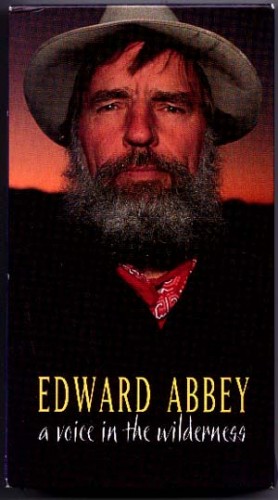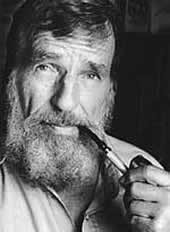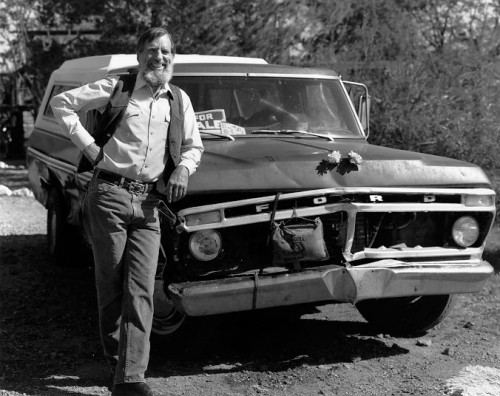lundi, 30 novembre 2009
Edward Abbey, Conservative Anarchist
 Edward Abbey, Conservative Anarchist
Edward Abbey, Conservative Anarchist
By Bill Croke / http://newrightamerica.blogspot.com/
http://spectator.org/archives/2009/03/13/edward-abbey-conservative-anar
Cactus Ed (a nickname he liked) is dead, lo these twenty years (March 14, 1989). He was a less controversial figure in his time than he is today, and certainly has more readers. I recently attended a lecture/book discussion on the author's Desert Solitaire at my local public library, and wasn't surprised by what I heard. Small town book clubs tend to be the pet projects of liberals bent on "promoting literacy," and attract likeminded people. The discussion was moderated by a local Abbey fan, a woman of some academic credentials, and roughly twenty people took part. I've read Desert Solitaire twice, but went to the lecture on a whim, only flipping through my paperback copy shortly beforehand, intending to just listen. The group chewed over the book for 90 minutes, and the takeaway for me was that most people there thought Abbey to be a larger-than-life iconic character, the life transcending the work. And they mostly agreed with his severe critique of the management of the public lands, his ambiguous views on the national parks, and his anarchic thoughts concerning humankind's history and place on the planet, in general. An amusing evening.
Edward Abbey's posthumous fame lies mostly with the Green Left, especially in the West. He's attained that iconic cult status as a man who embodied equal parts Henry David Thoreau (Larry McMurtry once called him "The Thoreau of the American West") and John Muir, with an added dash of Mikhail Bakunin. Somebody who thought and wrote, but also acted, and influenced others to act, however indirectly. All this begs an old question: Does a writer pushing an agenda in his work compromise the artistic integrity of that work? In Abbey's case the answer is both yes and no, because he was much more a polemicist than an artist.
Edward Paul Abbey was born on January 29, 1927, in Indiana, Pennsylvania, the son of a farmer and logger. After a 1944 hitchhiking trip west at 17, he served in the U.S. Army late in World War II and afterwards, then enrolled at the University of New Mexico in 1948 on the G.I. Bill, eventually earning a Master's Degree in philosophy. During this time Abbey started to write as he began concurrently to explore the backcountry of the Southwest in his spare time, specifically the Four Corners area (where Utah, Colorado, Arizona, and New Mexico meet), otherwise known as the Colorado Plateau because it's drained by that great river.
It was among the last of Western regions to be surveyed and mapped. In 1869, John Wesley Powell was its primary explorer when he led a party in dories down the rapids-ravaged canyons of the Green and Colorado Rivers from Green River, Wyoming, all the way through the Grand Canyon. It's an unforgiving region of deserts and mountains, much of it federal land, and home to a half dozen national parks. Here Abbey found the subject that was the focus of his four decades as a writer.
Abbey started as a novelist with a run into the 1960s with series of competently executed but forgettable books such as Jonathan Troy (1954), The Brave Cowboy (1956), and Fire on the Mountain (1962). The Brave Cowboy was made into Lonely Are the Brave (1962), a film starring Kirk Douglas, thus earning Abbey some much-needed Hollywood money. During this time he also churned out essays and journalism about his wanderings in "the back of beyond."
Money was tight, though, and Abbey also worked odd jobs through the 1950s and '60s. His most noteworthy employment was as a seasonal ranger at Arches National Monument (now Arches National Park) near Moab, Utah, in 1959. This experience (along with others) culminated in the 1968 publication of Desert Solitaire, the book that made his reputation. After that, Cactus Ed became the Thoreau of the West.
 The book is in some ways an episodic pastiche. Abbey alternates vividly written chapters describing the multi-hued landscapes of Arches and elsewhere with others featuring cranky polemics about Bureau of Reclamation river dams and "Industrial Tourism." But those sharp landscape renderings are some of the finest writing extant about the desert Southwest. Here he is in Glen Canyon before the eponymous dam was built (1963) that created Lake Powell:
The book is in some ways an episodic pastiche. Abbey alternates vividly written chapters describing the multi-hued landscapes of Arches and elsewhere with others featuring cranky polemics about Bureau of Reclamation river dams and "Industrial Tourism." But those sharp landscape renderings are some of the finest writing extant about the desert Southwest. Here he is in Glen Canyon before the eponymous dam was built (1963) that created Lake Powell:The sandstone walls rise higher than ever before, rounding off on top as half-domes and capitols, golden and glowing in the sunlight, a deep radiant red in the shade.
And this from the same trip:
Beyond the side canyon the walls rise again, slick and monolithic, in color a blend of pink, buff, yellow, orange, overlaid in part with a glaze of "desert varnish" (iron oxide) or streaked in certain places with vertical draperies of black organic stains, the residue from plant life beyond the rim and from the hanging gardens that flourish in the deep grottoes high on the walls. Some of those alcoves are like great amphitheatres, large as the Hollywood Bowl, big enough for God's own symphony orchestra.
Companions to Desert Solitaire are the essays found in such collections as The Journey Home (1977), Abbey's Road (1979), Down the River (1982), Beyond the Wall (1984), and One Life at a Time, Please (1988). The subjects of the essays (the form being possibly Abbey's greatest strength as a writer) vary from detailed accounts of his wanderings -- rafting the Colorado, exploring such landscape oddities as the San Rafael Swell or Big Bend National Park -- to passionate polemics against national park infrastructure development or Bureau of Land Management (BLM) policies on leasing grazing land to ranchers. The latter type showed that Abbey would have done well as an 18th-century pamphleteer. In an essay entitled "Eco-Defense," he writes: "Eco-defense is risky but sporting; unauthorized but fun; illegal but ethically imperative…Spike those trees; you won't hurt them; they'll be grateful for the protection; and you may save the forest. Loggers hate nails."

Abbey's most controversial role was only obliquely related to his work. In 1975 he published his novel The Monkey Wrench Gang, a book that alongside Desert Solitaire enhanced his reputation as an environmentalist, but unlike the latter tome it has prose as purple as an Arizona sunset. The plot involves four anarchic enviros who conspire to blow up Glen Canyon Dam. In a case of life imitates art, the book inspired the establishment of a notorious radical green group in 1980 known as Earth First!, with Abbey as a charter member. Other noteworthy members were activist/writer Doug Peacock, and Dave Foreman, an ex-Goldwater Republican. Earth First! "membership" was and remains (to the extent that it even exists today) anonymous and shadowy, as it's known for acts of "monkey wrenching" of earthmoving and logging equipment, spiking trees, stealing survey stakes, cutting wire fences, and so on. "Earth First!" has spawned ancillary groups such as the Earth Liberation Front (ELF), which before its downfall at the hands of the FBI in 2006 burned down a Colorado ski lodge, and destroyed a number of vehicles at an SUV dealership in Eugene, Oregon, among other acts of domestic terrorism.
Cactus Ed was a prickly sort; a conservative anarchist, if you will, who on one hand could support eco-terrorism (a favorite motto was: "Keep America Beautiful -- Burn a Billboard!"), and on the other supported the National Rifle Association (NRA), and restrictions on immigration. When he died of natural causes, some of his Earth First! compatriots famously and illegally absconded with his body, and buried it in a secret place in remote desert outside of Tucson. And there he lies to this day, pushing up cactus.
00:20 Publié dans Philosophie | Lien permanent | Commentaires (0) | Tags : etats-unis, conservatisme, anarchisme de droite, anarchisme |  |
|  del.icio.us |
del.icio.us |  |
|  Digg |
Digg | ![]() Facebook
Facebook



Les commentaires sont fermés.